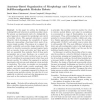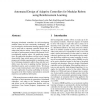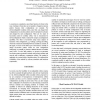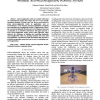129
Voted
NCA
2010
IEEE
14 years 7 months ago
2010
IEEE
In this paper we address the challenge of realizing full-body behaviors in scalable modular robots. We present an experimental study of a biologically inspired approach to organize...
106
Voted
ICRA
2010
IEEE
14 years 11 months ago
2010
IEEE
— Modular robots can potentially assemble into a wide range of configurations to locomote in different environments. However, designing locomotion strategies for each configura...
84
Voted
ICRA
2010
IEEE
14 years 11 months ago
2010
IEEE
Abstract— In this paper we study online gait optimization for modular robots. The learning strategy we apply is distributed, independent on robot morphology, and easy to implemen...
96
Voted
ICRA
2010
IEEE
14 years 11 months ago
2010
IEEE
— Stochastic self-reconfiguring robots are modular robots that possess the ability to autonomously change the arrangement of their modules and do so through the use of nondetermi...
103
click to vote
IJRR
2008
15 years 22 days ago
2008
Designing distributed controllers for self-reconfiguring modular robots has been consistently challenging. We have developed a reinforcement learning approach which can be used bo...
92
Voted
ICRA
2003
IEEE
15 years 6 months ago
2003
IEEE
Locomotion is considered as most basic function of robots. In the case of ordinary robots, they are not needed to change locomotion pattern because their configurations are consta...
103
Voted
IROS
2006
IEEE
15 years 6 months ago
2006
IEEE
– Self-reconfigurable robots are modular robots that can autonomously change their shape and size to meet specific operational demands. Recently, there has been a great interest ...
96
Voted
ICRA
2006
IEEE
15 years 6 months ago
2006
IEEE
Abstract— The Deformatron robot is a homogeneous, modular robot. The Deformatron modules can play one of three roles in the physical structure of the robot: bone, tendon, and mus...
103
click to vote
ICRA
2007
IEEE
15 years 7 months ago
2007
IEEE
Abstract— Tightly-coupled multi-agent systems such as modular robots frequently exhibit properties of interest that span multiple modules. These properties cannot easily be detec...
127
Voted
SASO
2008
IEEE
15 years 7 months ago
2008
IEEE
— A reconfigurable robot is a robot that can change shape. Programming reconfigurable robots is complicated by the need to adapt the behavior of each of the individual module t...




